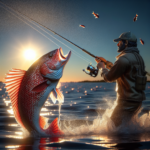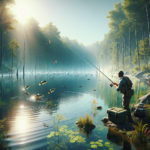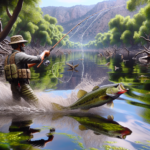Shore Fishing for Red Drum in South Carolina’s Coastal Waters

Introduction
Imagine standing on the sandy shores of South Carolina, the sun setting behind you, casting a golden hue over the water. Suddenly, your line tightens, and you feel the powerful pull of a Red Drum. This exhilarating experience is what shore fishing for Red Drum in South Carolina’s coastal waters is all about.
In this article, we will explore the ins and outs of shore fishing for Red Drum in South Carolina. We will cover the historical and cultural significance of this activity, the best fishing techniques, species information, top fishing spots, seasonal considerations, and much more. Whether you are a seasoned angler or a beginner, this guide will provide you with valuable insights to enhance your fishing experience.
Shore fishing for Red Drum is not just a pastime; it’s a way to connect with nature, enjoy the outdoors, and potentially catch one of the most sought-after fish in the region. Understanding the best techniques, gear, and locations can make all the difference in your success and enjoyment.
Background/Context
Historical or Cultural Significance
Red Drum, also known as Redfish or Channel Bass, have been a staple in South Carolina’s coastal waters for centuries. Native Americans and early settlers relied on these fish for sustenance. Today, Red Drum fishing is a popular recreational activity, deeply embedded in the local culture. The fish is celebrated for its fighting spirit and delicious taste, making it a prized catch among anglers.
Geographical Overview
South Carolina’s coastline stretches over 187 miles, featuring a diverse range of ecosystems, including estuaries, salt marshes, and barrier islands. The region’s mild climate and abundant waterways create an ideal habitat for Red Drum. Key areas for shore fishing include the Charleston Harbor, Myrtle Beach, and the numerous inlets and bays along the coast.
Key Points/Details
Fishing Techniques
Technique Overview
Shore fishing for Red Drum typically involves surf fishing, where anglers cast their lines from the beach into the surf zone. Other effective techniques include using live bait, artificial lures, and fly fishing.
When and Where to Use
The best times to fish for Red Drum are during the early morning and late afternoon when the fish are most active. Key locations include sandy beaches, inlets, and estuaries where Red Drum are known to feed.
Recommended Gear
- Rods: Medium to heavy action surf rods (8-12 feet).
- Reels: Spinning reels with a high line capacity (20-30 lb test line).
- Lines: Braided or monofilament lines (20-30 lb test).
- Bait: Live bait such as shrimp, mullet, or crabs; artificial lures like soft plastics and spoons.
Species Information
Species Overview
Red Drum are known for their distinctive reddish-bronze color and a black spot near the tail. They inhabit shallow coastal waters and are often found in estuaries and bays. Red Drum are opportunistic feeders, preying on crustaceans, small fish, and mollusks.
Best Practices
To successfully catch Red Drum, use live bait or lures that mimic their natural prey. Cast your line near structures like jetties, piers, and sandbars where Red Drum are likely to be feeding. Patience and persistence are key, as these fish can be elusive.
Location Information
Top Fishing Spots
- Charleston Harbor: Known for its rich marine life and easy access points.
- Myrtle Beach: Offers a variety of fishing spots along its extensive coastline.
- Murrells Inlet: A prime location for shore fishing with abundant Red Drum populations.
- Edisto Beach: A quieter spot with excellent fishing opportunities.
Regulations and Licenses
Anglers must adhere to South Carolina’s fishing regulations, which include size and bag limits for Red Drum. A valid South Carolina saltwater fishing license is required for all anglers aged 16 and older. The current regulations allow for the possession of 3 Red Drum per person per day, with a slot limit of 15-23 inches.
Seasonal Considerations
Seasonal Variations
Fishing conditions for Red Drum vary throughout the year. Spring and fall are considered the best seasons, as Red Drum are more active and closer to shore. Summer can also be productive, but anglers may need to fish during cooler parts of the day. Winter fishing is less common but can still yield good results in deeper waters.
Best Times to Fish
The optimal times to fish for Red Drum are during the early morning and late afternoon. Tidal movements also play a crucial role; fishing during incoming or outgoing tides can increase your chances of success.
Events and Tournaments
Event Overview
South Carolina hosts several fishing tournaments and events throughout the year, attracting anglers from all over. Notable events include the Charleston Harbor Tarpon Release Tournament and the Edisto Beach King Mackerel Tournament, which often feature categories for Red Drum.
Preparation Tips
To prepare for a fishing tournament, ensure your gear is in top condition, practice your casting techniques, and familiarize yourself with the tournament rules. Pre-fishing the area can also give you a competitive edge.
Tips and Best Practices
General Tips
- Always check the weather and tide conditions before heading out.
- Use fresh bait to increase your chances of attracting Red Drum.
- Be patient and persistent; fishing can require time and effort.
Avoid Common Mistakes
- Overcasting: Red Drum often feed close to shore, so avoid casting too far out.
- Ignoring Tides: Tidal movements significantly impact fish behavior; plan your fishing trips accordingly.
- Using the Wrong Gear: Ensure your gear is suitable for surf fishing and can handle the size and strength of Red Drum.
Advanced Techniques
- Fly Fishing: For a more challenging experience, try fly fishing for Red Drum using shrimp or crab imitations.
- Night Fishing: Red Drum can be more active at night; use glow-in-the-dark lures or bait to attract them.
Gear and Equipment Recommendations
Essential Gear
- Medium to heavy action surf rods (8-12 feet)
- Spinning reels with a high line capacity (20-30 lb test line)
- Braided or monofilament lines (20-30 lb test)
- Live bait such as shrimp, mullet, or crabs
- Artificial lures like soft plastics and spoons
Optional Gear/Upgrades
- Waders for fishing in deeper waters
- Tackle box with a variety of lures and hooks
- Fishing cart for transporting gear along the beach
Where to Buy or Rent
Local bait and tackle shops in South Carolina, such as Haddrell’s Point Tackle and The Charleston Angler, offer a wide range of fishing gear. Online retailers like Bass Pro Shops and Cabela’s also provide extensive selections.
Safety and Conservation
Safety Tips
- Always wear a life jacket when fishing near deep waters or strong currents.
- Be aware of weather conditions and avoid fishing during storms or high winds.
- Use sunscreen and stay hydrated to protect yourself from sun exposure.
Conservation Practices
- Practice catch and release to help maintain Red Drum populations.
- Respect local wildlife and avoid disturbing their habitats.
- Follow all fishing regulations and report any violations to authorities.
Planning Your Trip
Accommodations
South Carolina offers a variety of accommodations near popular fishing spots. Options range from beachfront hotels and vacation rentals to campgrounds and RV parks. Notable places to stay include The Sanctuary at Kiawah Island and Myrtle Beach State Park.
Travel Tips
South Carolina’s coastal areas are easily accessible by car, with major highways connecting key cities. Charleston International Airport and Myrtle Beach International Airport offer convenient air travel options. Renting a car is recommended for exploring different fishing spots.
Additional Activities
When not fishing, visitors can enjoy other activities such as exploring historic Charleston, visiting the Myrtle Beach Boardwalk, or taking a boat tour of the coastal waterways. South Carolina’s rich history and natural beauty provide plenty of opportunities for adventure and relaxation.
Frequently Asked Questions (FAQs)
What is the best time of year to fish for Red Drum in South Carolina?
The best times to fish for Red Drum are during the spring and fall when the fish are more active and closer to shore.
Do I need a fishing license to fish for Red Drum in South Carolina?
Yes, a valid South Carolina saltwater fishing license is required for all anglers aged 16 and older.
What is the size and bag limit for Red Drum in South Carolina?
The current regulations allow for the possession of 3 Red Drum per person per day, with a slot limit of 15-23 inches.
What gear do I need for shore fishing for Red Drum?
Essential gear includes medium to heavy action surf rods, spinning reels with a high line capacity, braided or monofilament lines, and live bait or artificial lures.
Conclusion
Shore fishing for Red Drum in South Carolina’s coastal waters offers an exciting and rewarding experience for anglers of all skill levels. By understanding the best techniques, gear, and locations, you can increase your chances of success and fully enjoy this popular pastime. Remember to follow local regulations, practice conservation, and prioritize safety to ensure a positive and sustainable fishing experience.
Now that you have all the information you need, it’s time to grab your gear, head to the shore, and try your luck at catching a Red Drum. Happy fishing!




